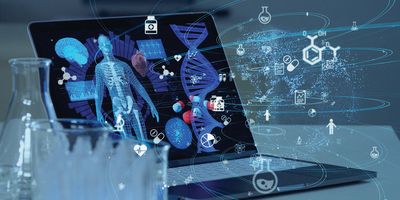Top 13 Safety Principles for Healthier Staff
Staff health must be a priority—here are fundamental safety tips to keep in mind
Health in the lab is critical to staff and benefits operations. Imagine what it’s like to not be healthy due to your work—how that would affect your loved ones, coworkers, and work production and quality. Here are 13 safety principles for healthier staff:
Tip 1: Focus on health and hygiene overall
Biosafety is all about our biology, so focusing on our health and hygiene makes intuitive sense. Researchers and others in fields like biomedical engineering and life sciences already focus on improving human health, so initiatives promoting staff health are often welcomed.
Tip 2: Manage biosafety in the lab
Preventing exposure is key. How effective are your lab bio-risk management systems and processes? Here are a few questions to consider:
Do the biosafety cabinets operate correctly? Does their placement minimize air current disturbances?
If not, leakage risk increases, potentially exposing staff to harmful substances or pathogens.
What happens in the lab should stay in the lab. That's biosecurity in a nutshell.
Have staff been trained on the risks of unintended splashes, splatters, and aerosols from small items and movements (e.g., pipette tip disposal, removing gloves, etc.)? Show staff how absorbent material in pipette waste containers reduces splash and risk.
Are sharps managed throughout their lifecycle? Supply selection, procurement, placement, use, and disposal affect exposure risks.
Tip 3: Prevent biosecurity issues outside of the lab
What happens in the lab should stay in the lab. That’s biosecurity in a nutshell. One real world example: are lab coat and PPE systems managed well enough to prevent laundering at home, a pair of used gloves leaving the lab in a coat pocket, or safety glasses worn outside the lab? If lab coats or PPE are worn or carried out of the lab, especially to be brought home and laundered, what else is along for the ride? Contamination can migrate out of labs via lab coats, shoes, attire, PPE, regular waste containers, etc. Staff without a laundry system at work will naturally end up laundering their coats elsewhere, whether at home or at a laundromat.
Tip 4: Control acute toxic effects of chemicals
Toxicity often has the greatest effect on health. Fume hoods prevent inhaling toxins, but our skin contact isn’t always controlled. It serves as both a barrier and a route of entry via absorption. Do staff appreciate sensitizer contact risk? Our immune system produces allergic responses to some chemicals at very low levels. A chemical sensitivity can be a career-changing or ending condition. If staff become sensitive to acrylates, for example, they might have to leave lab work.
Additionally, do staff understand how metals (e.g., lead) can migrate from bench to gloves to mouth, nose, or eyes? It transfers from hand to mouth. It clings to clothes or footwear, easily transferring into homes and cars.
Tip 5: Further reduce chronic exposures and illnesses
Repeated low-level exposures to toxins with chronic effects months, years, or even decades later can be riskier than short-term acute exposures and their effects. How well do staff comprehend this, and what steps do they take to minimize low-level exposures? These exposures can be insidious with little to no obvious signs until the disease latency period is up and someone is sick.
Tip 6: Prevent downstream effects to others
Non-lab individuals (e.g., custodians and facilities) need to be protected as well. Consider if it’s safe for custodians to empty lab trashcans or for facilities to work on hoods and HVAC exhausts. Non-lab staff expect to work without significant risks.
Additionally, a developing fetus and baby is much more at risk than a healthy adult, and they need significant protection. Is your fetal protection plan up to date before a worker reports a pregnancy? By the time they know they’re pregnant, their baby shouldn’t have been exposed to teratogens, especially in the first trimester.
Tip 7: Minimize ergonomic factors and reduce repetitive risks
Know the F’s of ergonomics: force (applied), frequency (repetition), flexion (out of neutral posture or movement), fitness (less fit equals more risk), fit (the task to the worker, not vice versa), and family (genetics). Have tasks been assessed for ergonomic factors? What steps are taken to minimize musculoskeletal disorders and repetitive strain injuries?
Tip 8: Prevent exposures to fire, smoke, and toxic gases
Fires and smoke occur in labs and their buildings. What steps are taken to prevent them and minimize staff exposure? Educating staff about the risks of being overcome from inhaling smoke or toxic gases helps them focus on getting out quickly. Taking all exposures seriously, including follow-up medical attention, is important.
Tip 9: Reduce noise exposures
Sound levels may be more significant than realized. While noise is thought of as unwanted sound, all sounds contribute to loudness. Hearing loss from sound is often insidious—we don’t notice until it’s diminished. Are noise levels measured and monitored? Are staff trained in how sounds affect their hearing? Are steps taken to reduce noise and protect workers’ hearing? If any answer is “no,” take appropriate action.
Tip 10: Maintain healthy air quality in and out of the lab
Fume hoods aren’t 100 percent effective—face velocity isn’t the sole measure of effective air control. Other assessments need to be done to ensure hoods are maintained and used properly.1 Don’t overload the hood, keep objects off the bench using jacks or other elevating means, and reinforce these measures.
Hearing loss from sound is often insidious—we don't notice until it's diminished.
Tip 11: Educate staff about ionizing radiation risk reduction
How well are exposures to ionizing radiation minimized to be “as low as reasonably achievable” (ALARA)? ALARA is the key principle for minimizing ionizing radiation risk. By focusing on keeping potential exposures as low as possible, we can see the benefits of redundancies.
Tip 12: Appreciate the risks from non-ionizing radiation
Non-ionizing radiation is less powerful and less risky than ionizing. Yet, certain exposures can have serious impacts on our eyes and skin. Laser hazards vary between classes 1-4 with complex differences in effects and controls. Ultraviolet (UV) light type and strength also vary from beneficial (UV-B produces vitamin D in our bodies) to acute effects (burns) or chronic disease (cancer). How effectively are lasers and UV sources managed, including changes to laser path or controls and UV types or intensities?
Tip 13: Create an action plan
Your goal is simple: assess, remedy, and maintain a healthy environment. Determine what needs to be done to accomplish these three measures, then implement them. Your healthy staff (and their loved ones) will appreciate it, and your operations will benefit from it. Imagine a lab where everyone can be as healthy as possible thanks to a positive culture of health and safety.
References:
1. Albright, Chip. Laboratory Fume Hoods Explained. Jan. 2022. Accessed April 6, 2023. https://www.fumehoodcertified.com/laboratory-fume-hoods-explained. ISBN 978-1-7357110-1-0.



